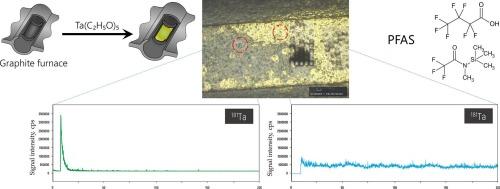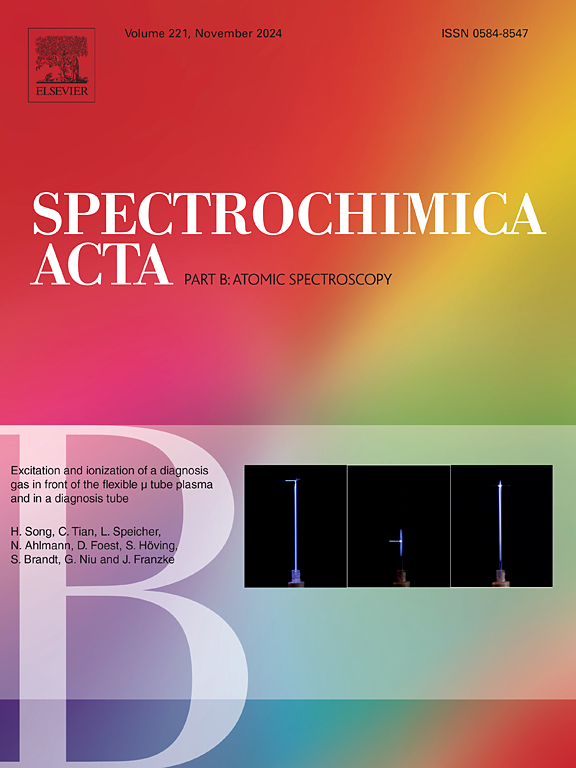钽改性石墨炉作为测定总氟的新方法及HR-CS-MAS间接PFAS分析
IF 3.8
2区 化学
Q1 SPECTROSCOPY
引用次数: 0
摘要
氟对环境和生物系统至关重要。然而,鉴于目前可用的仪器技术的分析能力有限,有必要开发新的方法来确定其含量。近年来,高分辨率连续源分子吸收光谱法(HR-CS-MAS)的应用前景广阔。在这种方法中,可以通过监测在改性剂混合物存在下形成的单氟化物的分子吸收来获得测定氟的最佳分析参数,其中形成单氟化物的元素和稳定物质是必不可少的。一个潜在的替代“改性剂鸡尾酒”是使用钽箔插入雾化器,以覆盖石墨表面。然而,考虑到钽箔有限的热机械强度,本研究考察了应用钽(V)乙醇溶液来指导石墨表面改性的可能性。本研究的目的是开发一种具有增强分析参数的氟测定简化方案。利用表面技术(TOF-SIMS和LA-ICP-MS)研究了石墨表面的形貌和化学成分。对所提出的氟测定方法的分析性能进行了评价,并与先前报道的方法进行了比较。采用优化后的时间-温度程序测定地下水中的氟含量,并将拟定的方案应用于PFAS中的氟分析。本文章由计算机程序翻译,如有差异,请以英文原文为准。

Tantalum-modified graphite furnace as a novel approach for total fluorine determination and indirect PFAS analysis by HR-CS-MAS
Fluorine is vital to the environment and biological systems. However, given the limited analytical capabilities of the instrumental techniques currently available, there is a need for the development of novel methodological approaches for its determination. It has recently been demonstrated that there is significant potential in applying high resolution continuum source molecular absorption spectrometry (HR-CS-MAS). In this approach, optimal analytical parameters for fluorine determination can be achieved by monitoring molecular absorption of monofluorides formed in the presence of a mixture of modifiers, in which monofluoride forming elements and stabilizing substances are essential. One potential alternative to the “modifier cocktail” is the use of tantalum foil inserted into the atomizer to cover the graphite surface. However, given the limited thermomechanical strength of the tantalum foil, this study examined the possibility of applying tantalum(V) ethoxide solution to direct the modification of the graphite surface. The objective of this study was to develop a simplified protocol with enhanced analytical parameters for fluorine determination. The morphology and chemical composition of the graphite surface were investigated using surface techniques (TOF-SIMS and LA-ICP-MS). The analytical performance of the proposed approach for fluorine determination was evaluated and compared with previously reported methods. The optimized time-temperature programme was used to determine the fluorine content in groundwater, and the protocol, which had been elaborated, was applied to analyze fluorine in PFAS.
求助全文
通过发布文献求助,成功后即可免费获取论文全文。
去求助
来源期刊
CiteScore
6.10
自引率
12.10%
发文量
173
审稿时长
81 days
期刊介绍:
Spectrochimica Acta Part B: Atomic Spectroscopy, is intended for the rapid publication of both original work and reviews in the following fields:
Atomic Emission (AES), Atomic Absorption (AAS) and Atomic Fluorescence (AFS) spectroscopy;
Mass Spectrometry (MS) for inorganic analysis covering Spark Source (SS-MS), Inductively Coupled Plasma (ICP-MS), Glow Discharge (GD-MS), and Secondary Ion Mass Spectrometry (SIMS).
Laser induced atomic spectroscopy for inorganic analysis, including non-linear optical laser spectroscopy, covering Laser Enhanced Ionization (LEI), Laser Induced Fluorescence (LIF), Resonance Ionization Spectroscopy (RIS) and Resonance Ionization Mass Spectrometry (RIMS); Laser Induced Breakdown Spectroscopy (LIBS); Cavity Ringdown Spectroscopy (CRDS), Laser Ablation Inductively Coupled Plasma Atomic Emission Spectroscopy (LA-ICP-AES) and Laser Ablation Inductively Coupled Plasma Mass Spectrometry (LA-ICP-MS).
X-ray spectrometry, X-ray Optics and Microanalysis, including X-ray fluorescence spectrometry (XRF) and related techniques, in particular Total-reflection X-ray Fluorescence Spectrometry (TXRF), and Synchrotron Radiation-excited Total reflection XRF (SR-TXRF).
Manuscripts dealing with (i) fundamentals, (ii) methodology development, (iii)instrumentation, and (iv) applications, can be submitted for publication.

 求助内容:
求助内容: 应助结果提醒方式:
应助结果提醒方式:


